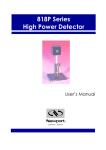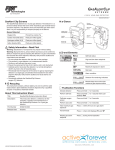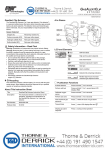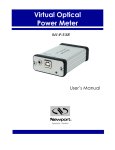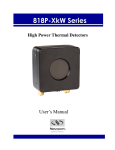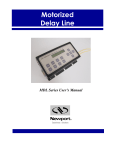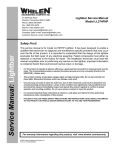Download Newport 818P Thermopile detector
Transcript
818P Series High Power Detector User’s Manual i Warranty Newport Corporation warrants that this product will be free from defects in material and workmanship and will comply with Newport’s published specifications at the time of sale for a period of one year from date of shipment. If found to be defective during the warranty period, the product will either be repaired or replaced at Newport's option. To exercise this warranty, write or call your local Newport office or representative, or contact Newport headquarters in Irvine, California. You will be given prompt assistance and return instructions. Send the product, freight prepaid, to the indicated service facility. Repairs will be made and the instrument returned freight prepaid. Repaired products are warranted for the remainder of the original warranty period or 90 days, whichever is longer. Limitation of Warranty The above warranties do not apply to products which have been repaired or modified without Newport’s written approval, or products subjected to unusual physical, thermal or electrical stress, improper installation, misuse, abuse, accident or negligence in use, storage, transportation or handling. This warranty also does not apply to fuses, batteries, or damage from battery leakage. THIS WARRANTY IS IN LIEU OF ALL OTHER WARRANTIES, EXPRESSED OR IMPLIED, INCLUDING ANY IMPLIED WARRANTY OF MERCHANTABILITY OR FITNESS FOR A PARTICULAR USE. NEWPORT CORPORATION SHALL NOT BE LIABLE FOR ANY INDIRECT, SPECIAL, OR CONSEQUENTIAL DAMAGES RESULTING FROM THE PURCHASE OR USE OF ITS PRODUCTS. First printing 2004 © 2004 by Newport Corporation, Irvine, CA. All rights reserved. No part of this manual may be reproduced or copied without the prior written approval of Newport Corporation. This manual has been provided for information only and product specifications are subject to change without notice. Any change will be reflected in future printings. Newport Corporation 1791 Deere Avenue Irvine, CA, 92606 USA P/N 41313-01 Rev. C ii Declaration of Conformity We declare that the accompanying product, the model 818P, identified with the mark, meets the intent of the Electromagnetic Compatability Directive, 89/336/EEC and Low Voltage Directive 73/23/EEC. Manufacturer’s Name: Manufacturer’s Address: Type of Equipment: Model No.: Year of test & manufacture: Newport Corporation 1791 Deere Avenue Irvine, CA 92606 USA Laser Power Detector 818P 2002 Standard(s) to which Conformity is declared: Standard Description EN 61326 :1997 Limits and methods of measurement of radio interference characteristics of information technology equipment. Testing and measurements of conducted emission Limits and methods of measurement of radio interference characteristics of information technology equipment. Testing and measurements of radiated emission Electromagnetic compatibility (EMC) – Part 4: Testing and measurements techniques- Section 4.2: Electrostatic discharge. Electromagnetic compatibility (EMC) – Part 4: Testing and measurements techniques- Section 3: Radiated, Radio Frequency immunity. Radiated Electromagnetic field from digital radio telephones- immunity test 900MHz pulsed Electromagnetic compatibility (EMC) – Part 4: Testing and measurements techniques- Section 4: Electrical fast transient/burst immunity. Electromagnetic compatibility (EMC) – Part 4: Testing and measurements techniques- Section 6: Immunity to conducted Radio Frequency. EN 61326 : 1997 EN 61000-4-2:1995 EN 61000-4-3:1996 ENV 50204: 1995 EN 61000-4-4:1995 EN 61000-4-6:1996 Performance Criteria Class A Class A Class B Class A Class A Class B Class A I, the undersigned, hereby declare that the equipment specified above conforms to the above Directive(s) and Standard(s). Alain Danielo VP European Operations Zone Industrielle 45340 Beaune-la-Rolande, France Dan Dunahay Director of Quality Systems 1791 Deere Avenue Irvine, CA USA iii Technical Support Contacts North America & Asia Europe Newport Corporation Service Dept. Newport/MICRO-CONTROLE S.A. 1791 Deere Ave. Irvine, CA 92606 Zone Industrielle Telephone: (949) 253-1694 45340 Beaune la Rolande, FRANCE Telephone: (800) 222-6440 x31694 Telephone: (33) 02 38 40 51 56 Asia Newport Opto-Electronics Technologies 253 Aidu Road, Bld #3, Flr 3, Sec C, Shanghai 200131, China Telephone: +86-21-5046 2300 Fax: +86-21-5046 2323 Newport Corporation Calling Procedure If there are any defects in material or workmanship or a failure to meet specifications, promptly notify Newport's Returns Department by calling 1-800-222-6440 or by visiting our website at www.newport.com/returns within the warranty period to obtain a Return Material Authorization Number (RMA#). Return the product to Newport Corporation, freight prepaid, clearly marked with the RMA# and we will either repair or replace it at our discretion. Newport is not responsible for damage occurring in transit and is not obligated to accept products returned without an RMA#. E-mail: [email protected] When calling Newport Corporation, please provide the customer care representative with the following information: • • • Your Contact Information Serial number or original order number Description of problem (i.e., hardware or software) To help us diagnose your problem, please note the following conditions: • • • • Is the system used for manufacturing or research and development? • Can you identify anything that was different before this problem occurred? What was the state of the system right before the problem? Have you seen this problem before? If so, how often? Can the system continue to operate with this problem? Or is the system non-operational? iv Safety Information Do not use the 818P detector if it looks damaged, or if you suspect that the 818P is not operating properly. Appropriate installation must be done for water-cooled and fan-cooled detectors. Refer to the specific instructions for more information. The user must wait for a while before handling these detectors after power is applied. Surfaces of the detectors get very hot and there is a risk of injury if they are not allowed to cool down. Note: This equipment has been tested and found to comply with the limits for a Class B digital device, pursuant to part 15 of the FCC Rules. These limits are designed to provide reasonable protection against harmful interference in a residential installation. This equipment generates, uses, and can radiate radio frequency energy and, if not installed and used in accordance with the instructions, may cause harmful interference to radio communications. However, there is no guarantee that interference will not occur in a particular installation. If this equipment does cause harmful interference to radio or television reception, which can be determined by turning the equipment off and on, it is suggested to try to correct the interference by taking one or more of the following steps: • • • • Reorient or relocate the receiving antenna. Increase the distance between the equipment and receiver. Connect the equipment to an outlet that is on a different circuit than the receiver. Consult the dealer or an experienced radio/TV technician for help. SYMBOLS The following international symbols are used in this manual: Refer to the manual for specific Warning or Caution information to avoid any damage to the product. v Table of Contents Warranty i Declaration of Conformity ii Technical Support Contacts iii Safety Information iv List of Illustrations vi 1 General Information 1 1.1 1.2 Introduction................................................................................. 1 818P Series DB-15 Connector .................................................... 2 2 Specifications 2.1 2.2 Standard Operating Mode ......................................................... 3 Calorimeter Mode....................................................................... 7 3 Operating Instructions 3.1 3.2 3.3 3.4 3.5 8 Detector Preparation .................................................................. 8 3.1.1 Fan-Cooled Detectors ..................................................... 8 3.1.2 Water-cooled detectors ................................................... 8 Using with the 841-PE or 841-P-USB........................................ 9 Using without the 841-PE or 841-P-USB .................................. 9 Safety Notes ............................................................................... 11 3.4.1 Diffusive surfaces .......................................................... 11 3.4.2 Detector temperature.................................................... 11 Damage to the Optical Absorber Material ............................. 11 4 Service Information 4.1 3 12 Service Form.............................................................................. 13 Appendix A: Custom Heat Sink 15 vi List of Illustrations Figure 1 Tapped hole positions - 818P-XX-19 ....................................... 15 Figure 2 Tapped hole positions - 818P-XX-25 and 818P-XX-55 .......... 16 GET FREE UPDATES Check Newport’s website periodically for firmware, software and manual updates. Go to www.newport.com for the latest versions. 1 1 General Information 1.1 Introduction Newport’s 818P Series High Power Detector’s are thermopile devices that are specifically designed to work with Newport’s 841-PE Hand-Held Power/Energy Meter or the 841-P-USB Virtual Meter. They may also be used with other instruments by means of various adapter cables (see Sections 1.2 & 3.3 for more information). The 818P Series Detectors may be grouped into four distinct product families, based on active area size: • 818P-XX-12 detectors have dimensions of 38 x 38 mm and an aperture of 12 mm. • 818P-XX-18 detectors have dimensions of 50 x 50 mm and an aperture of 18 mm. • 818P-XX-19 detectors have dimensions of 50 x 50 mm and an aperture of 19 mm. • 818P-XX-25 detectors have dimensions of 89 x 89 mm and an aperture of 25 mm. • 818P-XX-55 detectors have dimensions of 89 x 89 mm and an aperture of 55 mm. The 818P-XX-18 detectors utilize surface absorber sensors and are designed for use at high average power densities. Within each group are various individual detectors with different cooling options: stand alone, heat sink, fan or water. The 818P detectors can measure between: • 10 mW and 70 W of average power for 818P-XX-12 series. • 10 mW and 30 W of average power for 818P-XX-18 series. • 20 mW and 150 W of average power for 818P-XX-19 series. • 60 mW and 300 W of average power for 818P-XX-25 series. • 100 mW and 400 W of average power for 818P-XX-55 series. 2 All 818P series detectors are supplied with a 180 cm flexible cable with a DB-15 connector termination. More about this connector in the next section. CAUTION To eliminate possible damage, do not carry the detector using the connector cable. When using a detector with a heat sink, the fins should always be oriented vertically. Call your nearest Newport distributor to replace the sensor disk and/or to recalibrate the detector. 1.2 818P Series DB-15 Connector The DB-15 male connector found at the end of the cable contains an EEPROM (Erasable Electrical Programmable Read-Only Memory) programmed with calibration sensitivity and other data relating to the specific 818Pdetector in use. Fast set-ups are attained because the 841-PE Handheld Meter and the 841-P-USB Virtual Meter automatically adjusts to the characteristics of the detector after reading the EEPROM. The 818E EEPROM can also be read by Newport’s 1835-C and 2835-C meters when using the 818PDIN adapter cable (sold separately). The DB-15 connector pin-out is as follows: 1USED BY 841-PE 2" " " 3" " " 4" " " 5" " " 6“+” SIGNAL OUTPUT 7USED BY 841-PE 8" " " 9" " " 10" " " 11" " " 12" " " 13“-“ SIGNAL OUTPUT 14USED BY 841-PE 15" " " SHELLCOAX SHIELD / BODY GRND 3 2 Specifications 2.1 Standard Operating Mode The following four tables contain specifications when operating in the standard power mode (i.e. when measuring average power, in Watts). 818P-010/ 020/ 070-12 Effective Aperture Diameter Wavelength Range Power Noise Level Calibration Uncertainty Linearity with Power Repeatability (Precision) Power Resolution Max. Average Power 818P-010-12 818P-020-12 818P-070-12 Max. Average Power (2 min)1 818P-010-12 818P-020-12 818P-070-12 Max. Average Power Density @ 1.064 µm, 10W CW @ 10.6 µm, 10W CW Pulsed Laser Damage Thresholds 1.064 µm, 360 µs, 5 Hz 1.064 µm, 7 ns, 10 Hz 532 nm, 7 ns, 10 Hz 266 nm, 7 ns, 10 Hz Dimensions (H x W x D) mm 818P-010-12 818P-020-12 818P-070-12 Weight (kg) 818P-010-12 818P-020-12 818P-070-12 Minimum Cooling Flow2 Recommended Cooling Flow Cooling Typical Sensitivity Recommended Load Impedance Typical Rise Time (0-95%) Linearity vs. Beam Dimension 1 12 mm 190nm – 11µm 1 mW ±2.5 % ±2 % ±0.5 % ±0.5 % 10 W 20 W 70 W 15 W 30 W 90 W 36 kW/cm2 11 kW/cm2 Max. Energy Density 5 J/cm2 1.0 J/cm2 0.6 J /cm2 0.3 J /cm2 Peak Power Density 14 kW/cm2 143 MW/cm2 86 MW/cm2 43 MW/cm2 38 x 38 x 14 38 x 38 x 45 38 x 38 x 32 0.13 0.15 0.19 0.5 liter/min 1.0 liter/min Heat sink / water 0.6 mV/W 100 kΩ 1.6s (0.3s with anticipation) ±0.7 % cooling : minimum 3 min. Water temperature ≤ 22°C, 1/8 NPT compression fittings for ¼ inch semi-rigid tube. 2 4 818P-15 / 30-18 Effective Aperture Diameter Wavelength Range Min. Measurable Power Power Noise Level Calibration Uncertainty Linearity with Power Repeatability (Precision) Power Resolution Max. Average Power 818P-15-18 818P-30-18 Max. Average Power (2 min.)3 818P-15-18 818P-30-18 Max. Average Power Density 1.064µm CW Pulsed Laser Damage Thresholds 1.064 µm , 360 µs, 10 Hz 1.064 µm , 7 ns, 10 Hz 532 nm , 7 ns, 10 Hz 266 nm , 7 ns, 10 Hz Dimension (H x W x D) mm 818P-15-18 818P-30-18 Weight (kg) 818P-15-18 818P-30-18 Cooling Typical Sensitivity Recommended Load Impedance Typical Rise time (0-95%) Linearity vs. Beam Dimension 18 mm 190 nm – 2.5 µm 20 mW 1 mW ±2.5% ±2% ±0.5% ±0.5% 15 W 30 W 23 W 40 W 110 W/cm2 Peak Power Density 30 kW/cm2 571 MW/cm2 428 MW/cm2 143 MW/cm2 Max. Energy Density 11 J/cm2 4 J/cm2 3 J /cm2 1J /cm2 50 x 50 x 20.6 50 x 50 x 56.3 0.16 0.21 Heat sink 0.8 mV/W 100 kΩ 7.7s (1.8s with anticipation) ±0.5% Specifications subject to change without notice 3 cooling : minimum 3 min. 5 818P-15 / 30 / 110 / 150-19 Effective Aperture Diameter Wavelength Range Min. Measurable Power Power Noise Level Calibration Uncertainty Linearity with Power Repeatability (Precision) Power Resolution Max. Average Power 818P-15-19 818P-30-19 818P-110-19 818P-150-19 Max. Average Power (2 min)4 818P-15-19 818P-30-19 818P-110-19 818P-150-19 Max. Average Power Density 1.064µm CW 10.6 µm CW Pulsed Laser Damage Thresholds 1.064 µm, 360 µs, 5 Hz 1.064 µm, 7 ns, 10 Hz 532 nm, 7 ns, 10 Hz 266 nm, 7 ns, 10 Hz Dimensions (H x W x D) mm 818P-15-19 818P-30-19 818P-110-19 818P-150-19 Weight (kg) 818P-15-19 818P-30-19 818P-110-19 818P-150-19 Minimum Cooling Flow5 Recommended Cooling Flow Cooling Typical Sensitivity Recommended load Impedance Typical Rise time (0-95%) Linearity vs. Beam Dimension 19 mm 190 nm – 11 µm 20 mW 1 mW ±2.5% ±2% ±0.5% ±0.5% 15 W 30 W 110 W 150 W 23 W 45 W 135 W 170 W 36 kW/cm2 11 kW/cm2 Peak Power Density 14 kW/cm2 143 MW/cm2 86 MW/cm2 43 MW/cm2 Max. Energy Density 5 J/cm2 1.0 J/cm2 0.6 J/cm2 0.3 J/cm2 50 x 50 x 20.6 50 x 50 x 56.3 54.2 x 54.2 x 55.6 50 x 50 x 33 0.16 0.21 0.25 0.24 0.5 liter/min 1.0 liter/min Heat sink / fan / water 0.7 mV/W 100 kΩ 2.8s (0.6s with anticipation) ±0.5 % Specifications subject to change without notice 4 cooling : minimum 3 min. Water temperature ≤ 22°C, 1/8 NPT compression fittings for ¼ inch semi-rigid tube. 5 6 818P-XX-25 818P-XX-55 Aperture Diameter Spectral Range Min. Measurable Power Power Noise Level Calibration Uncertainty Linearity with Power Repeatability (Precision) Power Resolution Max. Average Power Max. Average Power (2 min.)6 Max. Average Power Density 1.064µm CW 10.6 µm CW Pulsed Laser Damage Thresholds 1.064 µm, 360 µs, 5 Hz 1.064 µm, 7 ns, 10 Hz 532 nm, 7 ns, 10 Hz 266 nm, 7 ns, 10 Hz Dimensions (H x W x D) mm Weight (kg) Minimum Cooling Flow7 Cooling Typical Sensitivity Recommended Load Impedance Typical Response Time (0-95%) Linearity vs. Beam Dimension 818P-40/100/250/300-25 818P-40/100/300/400-55 25mm 55mm 190 nm-11 µm 60 mW 3 mW 100 mW 5 mW ±2.5% ±2% ±0.5% ±0.5% 40: 40 W 100: 100 W 250: 250 W 300: 300 W 40: 60 W 100: 150 W 250: 300 W 300: 300 W 40: 40 W 100: 100 W 300: 300 W 400: 400 W 40: 60 W 100: 150 W 300: 300 W 400: 400 W 45 kW/cm2 14 kW/cm2 Max. Energy Density 9 J/cm2 1.0 J/cm2 0.6J /cm2 0.3J /cm2 40: 89 x 89 x 32 100: 89 x 89 x 106 250: 89 x 89 x 116 300: 89 x 89 x 44 40: 0.68 100: 0.99 250: 1.44 300: 0.90 Peak Power Density 25 kW/cm2 143 MW/cm2 86 MW/cm2 43 MW/cm2 40: 89 x 89 x 32 100: 89 x 89 x 106 300: 89 x 89 x 116 400: 89 x 89 x 44 40: 0.62 100: 0.93 300: 1.38 400: 0.84 1 liter/min Heat sink/ Fan / Water 0.26 mV/W 0.13 mV/W >100kΩ >100kΩ 5s (1.3s with anticipation) 11s (2s with anticipation) ±0.5% ±0.5% Specifications subject to change without notice 6 7 cooling : minimum 3 min. Water temperature ≤ 22°C, 1/8 NPT compression fittings for ¼ inch semi-rigid tube. 7 2.2 Calorimeter Mode The 818P Series High Power Detectors have an optional mode that is called Calorimeter Mode. It allows you to measure single shot pulse energy. This mode is accessible when you use a 818P with an 841-PE, the 841-P-USB, or with your own data acquisition system. The following specifications apply specifically to this mode. For more information, refer to the 841-PE and the 841-P-USB instruction manuals or call Newport. 818P-XX-12 818P-XX-19 0.95 mV/J 0.63 J/W 150 ms 1.5 sec 50 ms 5J 20 mJ ±5% 0.7 mV/J 0.99 J/W 264 ms 4 sec 88 ms 15 J 200 mJ ±5% Typical Sensitivity Power Sensitivity / Energy Sensitivity Typical Rise Time Minimum Repetition Period Maximum Pulse Width Maximum Measurable Energy8 Minimum Measurable Energy Accuracy Typical Sensitivity Power Sensitivity / Energy Sensitivity Typical Rise Time Minimum Repetition Period Maximum Pulse Width Maximum Measurable Energy Minimum Measurable Energy Accuracy 818P-XX18 818P-XX-25 818P-XX55 0.3 mV/J 0.18 mV/J 0.03 mV/J 2.67 J/W 1.67 J/W 4.25 J/W 900 ms 8 sec 300 ms 28 J 550 mJ ±5% 370 ms 4.6 sec 123 ms 40 J 4J ±5% 1300 ms 11.1 sec 433 ms 200 J 5J ±5% Specifications subject to change without notice 8 For 1.064 µm; 360 µs pulses. 8 3 Operating Instructions 3.1 Detector Preparation Depending upon whether your particular detector is air-, fan-, or watercooled, some preliminary steps may be required, as follows: 3.1.1 Fan-Cooled Detectors Simply connect the fan to a power supply. 3.1.2 Water-cooled detectors Connect the detector head to a cooling water supply. Use with ¼’’ outer diameter plastic tubing. NOTE: The end of the tube must be cut perpendicular to the tubing; the portion of the outer tubing wall that slips into the fitting must not be deformed or damaged, otherwise the connection will not be water-tight. To connect the detector head fittings to the water supply tubing, unscrew the two parts of the fitting, push the tubing into the part not connected to the detector until it comes to the end of the fitting; then screw in the two parts of the fitting. The direction of flow through the head is unimportant. Once you have connected the fittings, check them for leaks. If you find a leak, check to see if the tubes are pushed in far enough and that the tubing has not been damaged. To disconnect the detector head fittings, remove the water pressure and drain the water from the tubing. Unscrew the two parts of the fitting and pull out the tubing. NOTE: Water will usually remain in the detector head after it is disconnected. It is possible to remove it by blowing it out, but be careful not to blow the water on yourself or on the detector aperture. Dry the detector body off before storing it. 9 Be sure that flow rates satisfy the minimum values, as indicated on the specifications pages (see Section 2). Time variations of water flow rates or water temperature will cause corresponding oscillations in measurements. 3.2 Using with the 841-PE or 841-P-USB Connect the DB15 connector at the end of the cable to the input connector on the 841-PE or the 841-P-USB meter (see the 841-PE or 841P-USB instruction manuals). Before performing the measurements, shield the detector head to prevent it from sensing heat from random sources. To obtain an accurate reading the 841-PE and the 841-P-USB meters must also be zero adjusted. Allow the detector head to thermally stabilize before making any measurements. Let the signal stabilize for a few seconds before adjusting the offset. Refer to the 841-PE and the 841-P-USB operating instructions for further details. For the most accurate measurements, center the beam on the sensor face. The beam diameter on the sensor should ideally be the same size as the beam diameter of the original calibration, which is 86.5% encircled power (>98% encircled power at full aperture) of a TEM 01 beam (at 1/e2) over 50% of the sensor’s surface (this complies with the International Electrotechnical Commission standard #1040: "Power and Energy Measuring Detector..."). 3.3 Using without the 841-PE or 841-P-USB The 818P Series High Power Detectors can be used with a voltmeter or oscilloscope. Usually these devices have a BNC input connector. For this reason, an adapter cable (Newport part number 818P-BNC) is available. This cable is sold separately. To make a measurement, follow these steps: 1. Let the detector head thermally stabilize for at least 10 minutes. 2. Connect the power head to a precision microvoltmeter, oscilloscope, or data acquisition system, with a load impedance that is greater than 100 kΩ. Because of the very low voltages at lower power levels for some of these detectors, analog or digital filters may be required to remove ambient electrical noise. 3. Remove the detector cover. 10 NOTE: For the most accurate measurements, center the beam on the sensor face. The beam diameter on the sensor should ideally be the same size as the beam diameter of the original calibration, which is 86.5% encircled power (>98% encircled power at full aperture) of a TEM 01 beam (at 1/e2) over 50% of the sensor’s surface (this complies with the International Electrotechnical Commission standard #1040: "Power and Energy Measuring Detector..."). WARNING: Be careful not to exceed the maximum levels and densities stated in the specifications. 4 Place the detector head into the laser beam path (the laser beam must be contained within the sensor area) for about a minute. 5. Block off any laser radiation to the detector. 6. Switch on the microvoltmeter and adjust its voltage range to the range required for the measurement. To determine the voltage range to be measured, refer to the detector head specifications (see Section 2): Vout = (expected power) x (calibration sensitivity of power detector) 7. Wait until the signal has stabilized (fluctuations representing less than 1% of the voltage level being measured are negligible), then measure the zero level voltage offset from the detector. Strong fluctuations in the zero level are usually caused by one of the following: - • Rapid fluctuations in the rate of water flow, • Rapid fluctuations in water temperature, • Strong drafts or stray radiation (especially visible when you are taking low power measurements), Ambient electrical noise (should be filtered out). 8. Apply the laser beam to the detector head. 9. Wait until the signal has stabilized (between one to three minutes for optimum measurements), then measure the voltage output from the detector (see Section 2 for individual detector 0-95% non anticipated response times). 10. The measured power is calculated as follows: Measured power = (output voltage - zero level voltage) / (calibration sensitivity) = 1000 x (Vout - Vzero level) / calibration sensitivity (mV/W) = Watts 11 3.4 Safety Notes 3.4.1 Diffusive surfaces When using the 818P, be aware of the ~ 5-15% diffused back reflection. Exception: the 818P-015/030-18 have a 5% specular reflection. As on any diffusive surface, the light on the sensor coating is scattered more or less uniformly as a Lambertian diffuser. It is recommended to use the detector with a black protective sleeve. This will limit wideangled diffused reflections. 3.4.2 Detector temperature Detectors can become hot enough during usage and can cause burns. 3.5 Damage to the Optical Absorber Material Damage to the optical absorber material is usually caused by exceeding the manufacturer's specified maximum incident: • Average Power Density • Pulse Energy Density Refer to the specifications pages (Section 2) for the 818P Series High Power Detector specifications. Damage may also be caused by using a detector with a contaminated absorber surface. Slight discoloration of the coating may occur, but this usually does not affect the calibration. In the event of major damage to the coating, the 818P Series sensors can be recoated. Contact your local Newport representative for information on repair and recalibration. See page iv: “Technical Support Contacts.” 12 4 Service Information The Model 818P High Power Detector contains no user serviceable parts. To obtain information regarding factory service, contact Newport Corporation or your Newport representative. Please have the following information available: 1. Detector model number (818P-XX) 2. Detector serial number (on rear panel) 3. Description of the problem. If the detector is to be returned to Newport Corporation, you will be given a Return Number, which you should reference in your shipping documents. Please fill out a copy of the service form, located on the following page, and have the information ready when contacting Newport Corporation. Return the completed service form with the instrument. To obtain warranty service, contact your nearest Newport agent or send the product, with a description of the problem, transportation and insurance prepaid, to the nearest Newport agent. Newport Corporation assumes no risk for the damage in transit. Newport Corporation will, at its option, repair or replace the defective product free of charge. However, if Newport Corporation determines that the failure is caused by misuse, alterations, accident or abnormal condition of operation or handling, you will be billed for the repair and the repaired product will be returned to you, transportation prepaid. 13 4.1 Service Form Newport Corporation U.S.A. Office: 800-222-6440 FAX: 949/253-1479 Name ___________________________________ Return Authorization # _________________ (Please obtain RA# prior to return of item) Company _______________________________________________________________________ Address _________________________________ Date _________________________________ Country __________________________________ Phone Number_________________________ P.O. Number______________________________ FAX Number __________________________ Item(s) Being Returned: Model # _________________________________ Serial #_______________________________ Description _____________________________________________________________________ ________________________________________________________________________________ ________________________________________________________________________________ ________________________________________________________________________________ ________________________________________________________________________________ ________________________________________________________________________________ Reason for return of goods (please list any specific problems): ________________________________________________________________________________ ________________________________________________________________________________ ________________________________________________________________________________ ________________________________________________________________________________ ________________________________________________________________________________ ________________________________________________________________________________ ________________________________________________________________________________ ________________________________________________________________________________ ________________________________________________________________________________ ________________________________________________________________________________ ________________________________________________________________________________ 14 Notes: 15 Appendix A: Custom Heat Sink Usually, the detector is calibrated and shipped with its final back panel. But the 818P can also be installed onto a heat sink supplied by the customer or onto another back panel. If this is the case, follow the instructions listed below. Instructions : 1. Remove the four front screws of the detector, being sure to hold together the front cover and the central housing. 2. Discard the back panel. 3. Apply thermal paste (for example Wakefield Engineering Inc. thermal paste part no. 120-2) to the back of the central housing to assure good thermal contact with the new back panel. 4. Recommended : Apply removable thread locker (for example Loctite removable thread locker 242) to the ends of the four original screws and into the four holes on back panel. 5. Use the four original screws to install the new back panel onto the detector. Be sure to apply the same torque to all four screws. Figure 1 Tapped hole positions - 818P-XX-19 16 Figure 2 Tapped hole positions - 818P-XX-25 and 818P-XX-

























